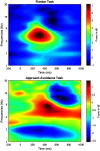Midfrontal Theta Activity Is Sensitive to Approach-Avoidance Conflict
- PMID: 36414005
- PMCID: PMC9581558
- DOI: 10.1523/JNEUROSCI.2499-21.2022
Midfrontal Theta Activity Is Sensitive to Approach-Avoidance Conflict
Abstract
Midfrontal theta (FMθ) in the human EEG is commonly viewed as a generic and homogeneous mechanism of cognitive control in general and conflict processing in particular. However, the role of FMθ in approach-avoidance conflicts and its cross-task relationship to simpler stimulus-response conflicts remain to be examined more closely. Therefore, we recorded EEG data while 59 healthy participants (49 female, 10 male) completed both an approach-avoidance task and a flanker task. Participants showed significant increases in FMθ power in response to conflicts in both tasks. To our knowledge, this is the first study to show a direct relationship between FMθ and approach-avoidance conflicts. Crucially, FMθ activity was task dependent and showed no cross-task correlation. To assess the possibility of multiple FMθ sources, we applied source separation [generalized eigendecomposition (GED)] to distinguish independent FMθ generators. The activity of the components showed a similar pattern and was again task specific. However, our results did not yield a clear differentiation between task-specific FMθ sources for each of the participants. Overall, our results show FMθ increases in approach-avoidance conflicts, as has been established only for more simple response conflict paradigms so far. The independence of task-specific FMθ increases suggests differential sensitivity of FMθ to different forms of behavioral conflict.SIGNIFICANCE STATEMENT FMθ is well established as an indicator for cognitive conflict in tasks involving simple stimulus-response conflicts. However, we do not yet know about its role in more complex forms of goal ambivalence, such as approach-avoidance conflicts. Thus, we implemented an approach-avoidance task and a flanker task to investigate FMθ in response to simple as well as more complex response conflicts. To our knowledge, this is the first study to show a direct relationship between FMθ and approach-avoidance conflicts. Although the transient FMθ increase is similar to that induced in a simple response conflict task, individual FMθ responsiveness to these two forms of conflict were independent of each other, suggesting intraindividual differences in the sensitivity of FMθ to different forms of behavioral conflict.
Keywords: FMT; approach avoidance; conflict processing; flanker task; midfrontal theta.
Copyright © 2022 the authors.
Figures






References
-
- Beldzik E, Ullsperger M, Domagalik A, Marek T (2022) Conflict- and error-related theta activities are coupled to BOLD signals in different brain regions Neuroimage 256:119264. - PubMed
MeSH terms
LinkOut - more resources
Full Text Sources
